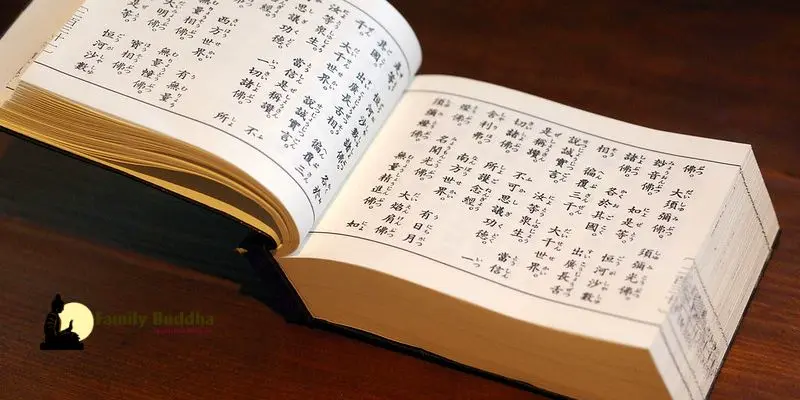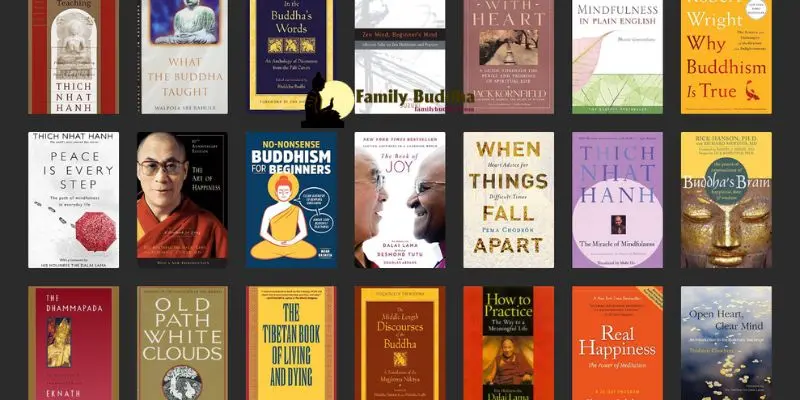The rich tapestry of Buddhist philosophy and practice is interwoven with the profound teachings encapsulated in its sutras. These sacred texts serve as guiding lights, illuminating the path to enlightenment for countless practitioners over the centuries. But where do these revered sutras originate, and what significance do they hold in the vast landscape of Buddhist thought? Let’s discover Buddhist sutras for beginners in this article at Familybuddha.com.
Origins of the Buddhist Sutras

The journey of the Buddhist sutras begins with the historical Buddha, Siddhartha Gautama, whose profound insights into the nature of existence formed the cornerstone of Buddhist teachings. Initially transmitted orally by the Buddha himself, these teachings were meticulously preserved and passed down through generations of monastic disciples.
The oral tradition played a vital role in the early dissemination of Buddhist doctrine. Monks committed themselves to memorizing and reciting the Buddha’s discourses, ensuring their preservation and transmission to future generations. This oral transmission continued for centuries until the advent of writing, which provided a more permanent means of recording the teachings.
The recorded sutras, written in various ancient languages such as Pali and Sanskrit, capture the essence of the Buddha’s teachings as well as the insights of subsequent Buddhist masters. These texts encompass a wide range of subjects, including ethics, meditation, philosophy, and cosmology, offering a comprehensive framework for spiritual development.
The Four Sutras: A Closer Look
Among the vast corpus of Buddhist sutras, certain texts hold particular significance due to their profound insights and practical relevance to spiritual practice. One such collection is the Yoga Sutras, attributed to the sage Patanjali, which provides a systematic exposition of the philosophy and practice of yoga.
Comprising 196 aphorisms divided into four chapters or “padas,” the Yoga Sutras offer invaluable guidance on the path to spiritual liberation. The first chapter, Samadhi Pada, elucidates the nature of Samadhi, or meditative absorption, and lays the foundation for the subsequent chapters.
The Sadhana Pada explores the practical aspects of spiritual practice, emphasizing discipline, devotion, and the various techniques of yoga. It delineates the stages of Kriyā yoga and Ashtanga yoga, providing a roadmap for the aspirant’s spiritual journey.
In the Vibhuti Pada, Patanjali expounds upon the supernormal powers (siddhis) that arise from advanced stages of meditation, underscoring the transformative potential of dedicated practice.
Finally, the Kaivalya Pada elucidates the ultimate goal of yoga: liberation (kaivalya) from the cycle of birth and death. It describes the nature of the liberated state and offers insights into the transcendent reality beyond ordinary perception.
Three Main Beliefs of Buddhism

Central to Buddhist philosophy are the three universal truths, which form the foundation of the Buddha’s teachings. These fundamental principles, known as the “three marks of existence,” provide profound insights into the nature of reality and the human condition.
The first truth, impermanence (anicca), asserts that all conditioned phenomena are transient and subject to change. This recognition of impermanence lies at the heart of Buddhist wisdom, reminding practitioners to cultivate detachment and equanimity in the face of life’s vicissitudes.
The second truth, suffering (dukkha), acknowledges the pervasive sense of dissatisfaction and discontent that characterizes human existence. By recognizing the inherent unsatisfactoriness of worldly pursuits, individuals can embark on the path to liberation from suffering.
The third truth, non-self (anatta), challenges the notion of a fixed and enduring self or ego. It suggests that the concept of a separate self is an illusion, arising from ignorance and clinging. Through insight meditation and self-inquiry, practitioners come to realize the interconnectedness and impermanent nature of all phenomena.
Main Books of Buddhism
Buddhism encompasses a vast array of sacred texts, each offering unique insights into the teachings of the Buddha and the path to enlightenment. Among these, three texts hold particular significance in various Buddhist traditions: the Mahayana Sutras, the Tibetan Book of the Dead, and the Tripitaka.
The Mahayana Sutras, revered by Mahayana Buddhists, constitute a vast collection of scriptures that expound upon the bodhisattva path and the cultivation of compassion and wisdom. These sutras include revered texts such as the Lotus Sutra, the Heart Sutra, and the Diamond Sutra, which continue to inspire and guide practitioners on the path to awakening.
The Tibetan Book of the Dead, also known as the Bardo Thodol, serves as a guidebook for navigating the intermediate states (bardos) between death and rebirth. Drawing upon Tibetan Buddhist cosmology and esoteric teachings, this profound text offers insights into the process of death and rebirth and provides practices for attaining liberation in the bardo realms.
The Tripitaka, or “Three Baskets,” constitutes the canonical scriptures of Theravada Buddhism, the oldest surviving school of Buddhism. This vast collection of texts is traditionally divided into three sections: the Vinaya Pitaka (discipline basket), the Sutta Pitaka (discourse basket), and the Abhidhamma Pitaka (higher teachings basket). Together, these texts provide a comprehensive framework for understanding the Buddha’s teachings and the monastic discipline.
Symbolism of the Dharma Wheel

Central to Buddhist iconography is the dharma wheel, or dharmachakra, a symbol of the Buddha’s teachings and the path to enlightenment. This ancient symbol holds profound significance within the Buddhist tradition, conveying the core principles of the Dharma in a visually compelling manner.
The dharma wheel typically consists of three main components: the hub, the rim, and the spokes. Each element symbolizes essential aspects of Buddhist doctrine and practice, offering insights into the nature of reality and the path to awakening.
The hub of the dharma wheel represents ethical conduct (sila), which forms the foundation of the Buddhist path. Ethical behavior, including non-harming, honesty, and compassion, is considered essential for spiritual progress and the cultivation of wholesome qualities.
The rim of the wheel symbolizes mindfulness (sati) and concentration (samadhi), which are integral to the practice of meditation. By cultivating mindfulness and concentration, practitioners develop clarity of mind and insight into the nature of reality, leading to profound spiritual transformation.
The spokes of the wheel represent the Noble Eightfold Path, the Buddha’s prescription for the cessation of suffering and the attainment of enlightenment. Each spoke signifies a different aspect of the path, including right understanding, right intention, right speech, right action, right livelihood, right effort, right mindfulness, and right concentration.
The number of spokes on the dharma wheel varies in different depictions, each configuration carrying its own symbolic significance. For example, the traditional eight-spoked wheel symbolizes the Noble Eightfold Path, while wheels with four, twelve, or twenty-four spokes represent other aspects of Buddhist doctrine and cosmology.
Five Buddhist sutras for beginners for Deeper Mindfulness
Within the vast expanse of Buddhist literature, certain sutras stand out for their profound wisdom and practical relevance to everyday life. These timeless teachings, presented in the form of dialogues between the Buddha and his disciples, offer invaluable insights into the nature of the mind and the path to inner peace.
The Diamond Sutra, revered in Mahayana Buddhism, expounds upon emptiness and the illusion of the self. Here, the Buddha elucidates the transient and insubstantial nature of all phenomena, challenging conventional perceptions and inviting practitioners to transcend dualistic thinking.
The Lankavatara Sutra delves into the nature of mind and consciousness, likening thoughts to a water-wheel or a machine perpetuating the cycle of rebirth. Through profound insights and allegorical teachings, this sutra invites contemplation on the nature of reality and the cessation of mental afflictions.
The Heart Sutra, perhaps the most concise yet profound of all Buddhist sutras, offers a penetrating analysis of the nature of emptiness. In just a few lines, it encapsulates the essence of Mahayana philosophy, emphasizing the interdependence and emptiness of all phenomena.
The Lotus Sutra, a cornerstone text in Mahayana Buddhism, presents a vast array of skillful means (upaya) for guiding sentient beings to enlightenment. Through parables, allegories, and dramatic narratives, the Lotus Sutra inspires practitioners to realize their inherent Buddha-nature and embark on the bodhisattva path of compassion and wisdom.
The Avatamsaka Sutra, also known as the Flower Garland Sutra, presents a majestic vision of reality encompassing infinite realms and interpenetrating dimensions. This profound text emphasizes the interconnectedness of all phenomena and the potential for boundless transformation and awakening.
Incorporating Buddhist Sutras into Practice
Buddhist sutras serve as invaluable guides for practitioners seeking to deepen their understanding of the Dharma and cultivate mindfulness and wisdom in their lives. Through study, reflection, and meditation on these sacred texts, practitioners can unravel the profound teachings of the Buddha and integrate them into their daily lives.
Chanting and recitation of sutras are common practices in many Buddhist traditions, serving as vehicles for invoking blessings, purifying negativities, and cultivating virtuous qualities. By engaging with the words and teachings of the Buddha, practitioners establish a spiritual connection with the lineage of enlightened beings and draw inspiration for their own journey of awakening.
Furthermore, the teachings of the Buddha are not exclusive to Buddhists but hold universal relevance for all seekers of truth and inner peace. The timeless wisdom contained within Buddhist sutras transcends cultural and religious boundaries, offering profound insights into the nature of the mind, the causes of suffering, and the path to liberation.
Conclusion
In conclusion, the Buddhist sutras represent a treasure trove of wisdom and guidance, offering profound insights into the nature of reality and the path to awakening. Rooted in the teachings of the Buddha and expounded upon by generations of enlightened masters, these Buddhist sutras for beginners continue to inspire and illuminate the spiritual journey of countless practitioners around the world. Through study, contemplation, and practice, may all beings discover the boundless wisdom and compassion of the Buddha’s teachings and realize the ultimate goal of liberation from suffering.










